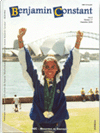Algumas considerações a respeito do sistema tátil de crianças cegas ou de visão subnormal
Abstract
O presente artigo trata da necessidade de se pesquisar sobre o sistema tátil. Cita alguns estudos brasileiros e internacionais relevantes sobre o sistema háptico. Aponta vieses científicos na interpretação de dados em algumas pesquisas sobre a produção e o reconhecimento de desenhos por cegos congênitos. Sugere algumas questões importantes e necessárias a serem investigadas, para um melhor conhecimento do tato e da capacidade háptica de sujeitos com limitação visual.
References
HELLER, M. A. Picture and pattern perception in the sighted and blind: The
advantage of the late blind. Perception, 18: 379-389, 1989.
HELLER, M.; CALCATERRA J. A.; GREEN, S. & LIMA, F. J. The eff ect of orientation on Braille recognition in persons who are sighted and blind . In: Journal of
Visual Impairment & Blindness, no. 7, volume 93: 416-419, 1999.
HELLER, M. A. Haptic perception in blind people . In: The psychology of touch (pp.
-261). M. A. Heller and W. Schiff (Eds.), Hillsdale/NJ: Lawrence Erlbaum Associates, 1991.
KATZ, D. The World of Touch . L. E. Krueger (Trans.), Hillsdale, N. J., Erlbaum, 1989.
LEDERMAN, S. J., & KLATZKY, R. L. Hand movements : A window into haptic object recognition. Cognitive Psychology, 19: 342-368. 1987.
LEDERMAN, S. J.; KLATZKY, R. L. & BARBER, P. O. Spatial and movement-based heuristics for encoding pattern information through touch . Journal of
Experimental Psychology: General, 114: 33-49, 1985.
LEDERMAN, S. J.; KLATZKY, R. L.; COLLINS, A. & WARDELL, J. Exploring
environments by hand or foot : Time-based heuristics for encoding distance in
movement space. Journal of Experimental Psychology: General, 13: 606-614,
LIMA, F. J. Representação mental de estímulos táteis . Dissertação (Mestrado) -
Faculdade de Filosofi a Ciências e Letras de Ribeirão Preto, Universidade de
São Paulo. Ribeirão Preto. 166p. 1998.
—— Questão de postura ou de taxonomia ? uma proposta. Benjamim Constant/Instituto Benjamim Constant/MEC. Centro de Pesquisa, Documentação e Informação. Rio de Janeiro: IBCENTRO, 2000.
LIMA, F. J & DA SILVA, J. Haptic identifi cation of twenty-two common objects :
the infl uence of distractors (resumo publicado). In: A Psychonomic Society
Publication, Philadelphia, Pennsylvania/USA. p. 21, 1997.
—— O desenho em relevo : uma caneta que faz pontos. Arquivos Brasileiros de
Psicologia, 50, 1/2: 144-151, 1998.
LIMA, F. J.; HELLER, M. & DA SILVA, J. Recodifi cação da captura háptica de
objetos tangíveis para uma transcrição pictórica . Arquivos Brasileiros de Psicologia, 50- 1/2: 124- 143, 1998a.
—— Drawings by the blind . Resumo publicado na Conference on Representation and Blindness. Republica di San Marino. 1998b.
LOOMIS, J. & LEDERMAN, S. Tactual perception . In: K. Boff, L. Kaufman, & J.
Thomas (Eds.), Handbook of human perception and performance . New York: Wiley, 1986.
MARSTON, J. R. & GOLLEDGE, R. Removing functional barriers : public transit
and the blind and vision impaired, 1997.
MILLAR, S. Spatial memory by blind and sighted children . British Journal of
Psychology, 66: 449-459, 1975.
MORSLEY, K., SPENCER, C. & BAYBUTT, K. Two techniques for encouraging
movement and exploration in the visually impaired child . British Journal of
Visual Impairment, 9: 75-78, 1991.
OKA, C. M. Mapas táteis são necessários ? Pôster apresentado no IX Congresso
Brasileiro de Educadores de Defi cientes Visuais. Guarapari/ES. 1999. (Cópia
eletrônica cedida ao primeiro autor, em comunicação pessoal, em janeiro de 2000.)
REVESZ, G. The psychology and art of the blind . London: Longmans Green,1950.
ROSA, A. & OCHAÍTA, E. Psicologia de la ceguera . Madrid: Alianza Psicologia,
SCHIFF, W. & FOULKE, E. Tactual perception : a sourcebook. New York: Cambridge University Press, 1982.
SPENCER, C.; BLADES. M. & MORSLEY, K. The child in the physical
environment : the development of spatial knowledge and cognition. Chichester:
Wiley, 1989.
UNGAR, S.J.; BLADES. M. & SPENCER, C. The role of tactile maps in mobility
training . British Journal of Visual Impairment, 11: 59-62, 1993.
—— Visually impaired children’s strategies for memorizing a map . British
Journal of Visual Impairment, 13: 27-32, 1995.
—— The ability of visually impaired children to locate themselves on a tactile map . Journal of Visual Impairment and Blindness, 90: 526-535, 1996a.
—— The construction of cognitive maps by children with visual impairments .
In: Portugali, J. (ed) The Construction of Cognitive Maps. Dordrecht: Kluwer
Academic Publishers, 1996b.
UNGAR, S.; BLADES, M.; SPENCER, C. & MORSLEY, K. Can visually impaired
children use tactile maps to estimate directions ? Journal of Visual Impairment & Blindness, 88: 221-233, 1994.
UNGAR, S.; ESPINOSA, A.; BLADES, M.; OCHAÍTA, E. & SPENCER, C. Blind and visually impaired people using tactile maps . Proceedings of the Association of
American Geographers Annual Meeting, Charlotte, North Carolina: Association
of American Geographers, 1996.
ZEDU, P. M. M.; YANO, A. M.; SOUZA, F. F & DA SILVA, J. A. Percepção visual e tatual-cinestésica de comprimento, área e volume em observadores normais e cegos . Psicologia: Teoria e Pesquisa. 8 (2): 253 –266, 1992.





.png)
